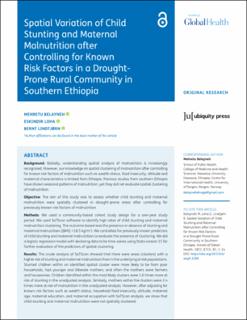| dc.description.abstract | Background: Globally, understanding spatial analysis of malnutrition is increasingly recognized. However, our knowledge on spatial clustering of malnutrition after controlling for known risk factors of malnutrition such as wealth status, food insecurity, altitude and maternal characteristics is limited from Ethiopia. Previous studies from southern Ethiopia have shown seasonal patterns of malnutrition, yet they did not evaluate spatial clustering of malnutrition.
Objective: The aim of this study was to assess whether child stunting and maternal malnutrition were spatially clustered in drought-prone areas after controlling for previously known risk factors of malnutrition.
Methods: We used a community-based cohort study design for a one-year study period. We used SaTScan software to identify high rates of child stunting and maternal malnutrition clustering. The outcome based was the presence or absence of stunting and maternal malnutrition ([BMI] <18.5 kg/m2). We controlled for previously known predictors of child stunting and maternal malnutrition to evaluate the presence of clustering. We did a logistic regression model with declaring data to be time-series using Stata version 15 for further evaluation of the predictors of spatial clustering.
Results: The crude analysis of SaTScan showed that there were areas (clusters) with a higher risk of stunting and maternal malnutrition than in the underlying at risk populations. Stunted children within an identified spatial cluster were more likely to be from poor households, had younger and illiterate mothers, and often the mothers were farmers and housewives. Children identified within the most likely clusters were 1.6 times more at risk of stunting in the unadjusted analysis. Similarly, mothers within the clusters were 2.4 times more at risk of malnutrition in the unadjusted analysis. However, after adjusting for known risk factors such as wealth status, household food insecurity, altitude, maternal age, maternal education, and maternal occupation with SaTScan analysis, we show that child stunting and maternal malnutrition were not spatially clustered.
Conclusion: The observed spatial clustering of child stunting and maternal malnutrition before controlling for known risk factors for child stunting and maternal malnutrition could be due to non-random distribution of risk factors such as poverty and maternal characteristics. Moreover, our results indicated the need for geographically targeted nutritional interventions in a drought-prone area. | en_US |

